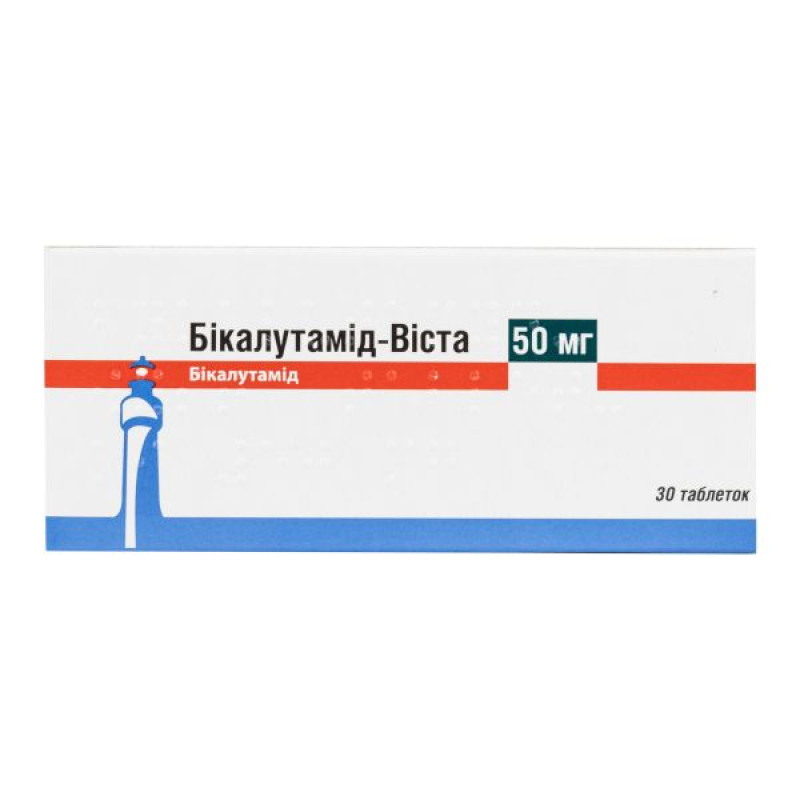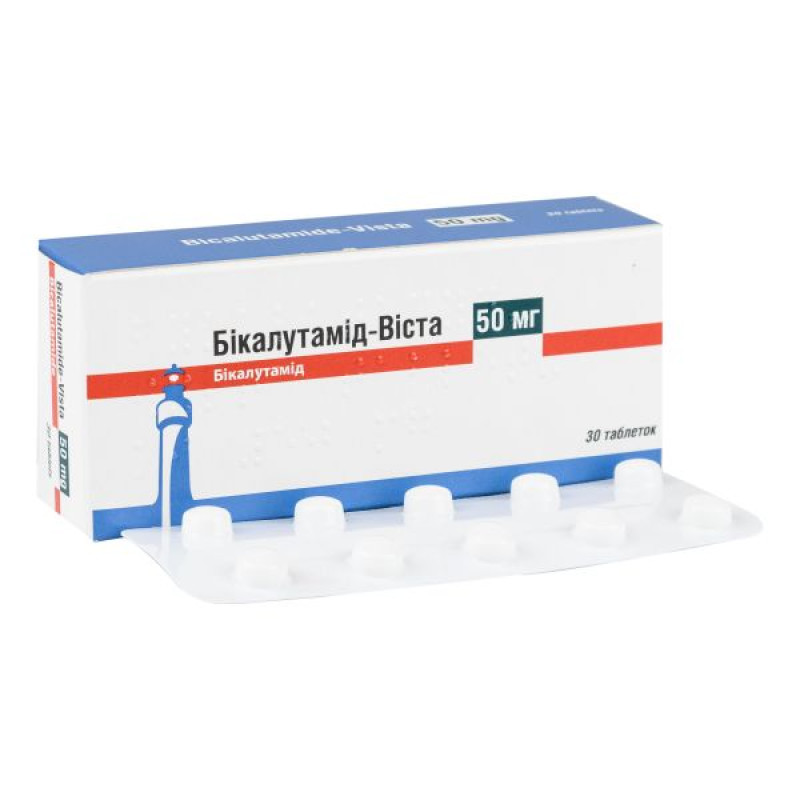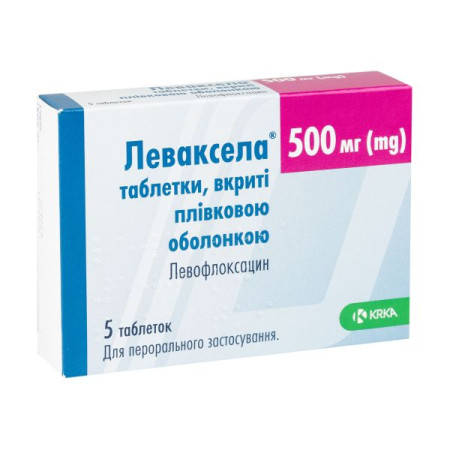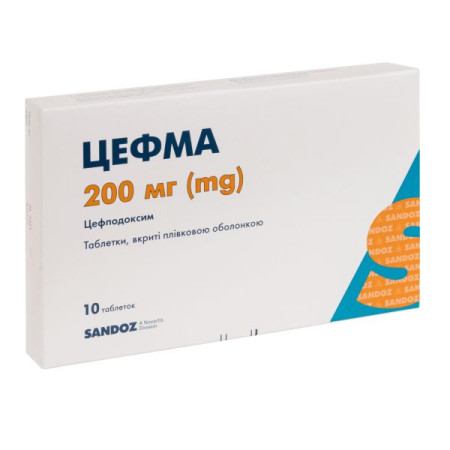Bicalutamide-Vista film-coated tablets 50 mg blister No. 30
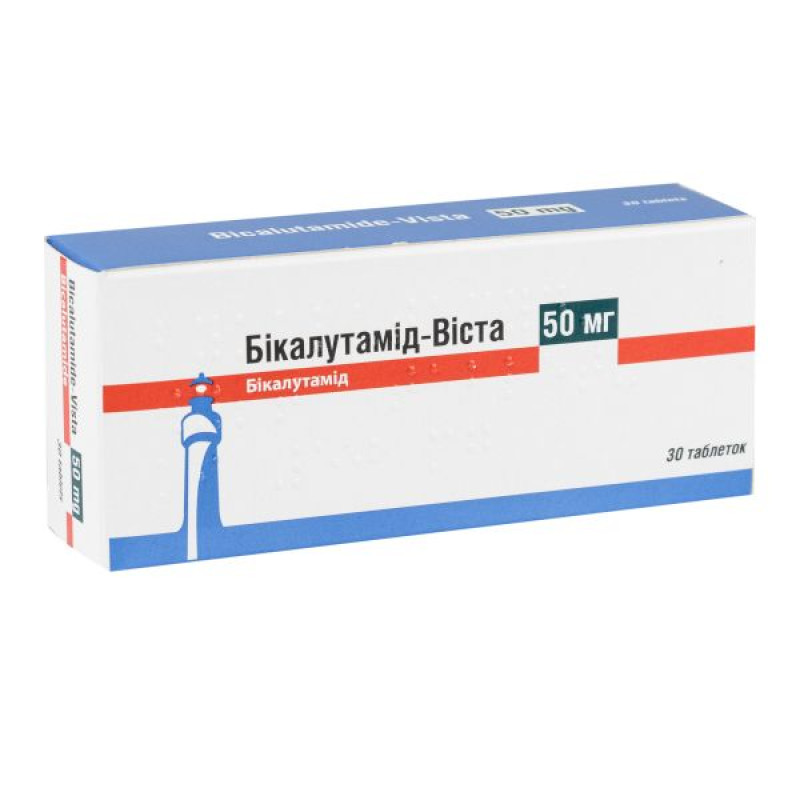
Instructions Bicalutamide-Vista film-coated tablets 50 mg blister No. 30
Composition
active ingredient: bicalutamide;
1 film-coated tablet contains 50 mg of bicalutamide;
excipients: lactose monohydrate, povidone, crospovidone, sodium lauryl sulfate, magnesium stearate; shell: lactose monohydrate, hypromellose, titanium dioxide (E 171), macrogol (PEG 4000).
Dosage form
Film-coated tablets.
Main physicochemical properties: white, round, biconvex, film-coated tablets. On one side of the tablets - engraving "ВСМ 50".
Pharmacotherapeutic group
Antiandrogenic agents. ATX code L02B B03.
Pharmacological properties
Pharmacodynamics.
Bicalutamide is a nonsteroidal antiandrogen that has no other effect on the endocrine system. The drug binds to androgen receptors without activating gene expression, thus inhibiting androgenic stimuli. As a result of inhibition, regression of the prostate tumor is observed. When bicalutamide is discontinued, a withdrawal syndrome may occur in a certain proportion of patients. Bicalutamide is a racemic mixture with antiandrogenic activity, represented almost exclusively by the (R)-enantiomer.
Pharmacokinetics.
Absorption.
Bicalutamide is well absorbed after oral administration. There is no evidence of a clinically significant effect of food intake on the bioavailability of the drug.
Distribution.
Bicalutamide is highly protein bound (racemate 96%, (R)-enantiomer > 99%) and is extensively metabolized (by oxidation and glucuronidation); its metabolites are excreted renally and biliarily in approximately equal amounts.
Biotransformation.
The (S)-enantiomer is eliminated very rapidly compared to the (R)-enantiomer; the elimination of the latter from the blood plasma is approximately 1 week. With daily administration of the drug bicalutamide, the (R)-enantiomer accumulates in the blood plasma in a 10-fold concentration due to its long half-life. A plateau concentration of the (R)-enantiomer at a level of approximately 9 μg/ml is observed with a daily dose of 50 mg of bicalutamide. In the stable phase, the predominantly active (R)-enantiomer accounts for 99% of the total circulating enantiomers.
Elimination (extraction).
In a clinical study, the mean concentration of (R)-bicalutamide in the semen of men receiving 150 mg of bicalutamide was 4.9 μg/mL. The amount of bicalutamide that could potentially enter a woman's body during sexual intercourse is low and may be approximately 0.3 μg/mL. This level is below that which has been shown to alter the offspring in laboratory animals.
Special patient groups.
The pharmacokinetics of the (R)-enantiomer are independent of age, renal impairment, or mild to moderate hepatic impairment. There is evidence that the (R)-enantiomer is cleared from plasma more slowly in patients with severe hepatic impairment.
Indication
Treatment of advanced prostate cancer in combination with luteinizing hormone-releasing factor (LHRH) analogue therapy or surgical castration.
Contraindication
Bicalutamide-Vista is contraindicated for use in women and children.
Bicalutamide-Vista should not be prescribed to patients who have experienced hypersensitivity reactions to the active substance or to any of the excipients included in the medicinal product.
Concomitant use of bicalutamide with terfenadine, astemizole, or cisapride is contraindicated.
Interaction with other medicinal products and other types of interactions
There is no evidence of a pharmacodynamic or pharmacokinetic interaction between bicalutamide and RFLG analogues.
In vitro studies have shown that R-bicalutamide is an inhibitor of CYP 3A4 and has a lesser inhibitory effect on the activities of CYP 2C9, 2C19 and 2D6.
Although clinical studies using antipyrine as a marker of cytochrome P450 (CYP) activity did not indicate a potential interaction with bicalutamide, the mean midazolam concentration (area under the pharmacokinetic curve) increased by up to 80% after co-administration for 28 days with bicalutamide. For drugs with a narrow therapeutic window, this increase may be significant. Therefore, concomitant use with terfenadine, astemizole and cisapride is contraindicated. Bicalutamide should also be used with caution with compounds such as cyclosporine and calcium channel blockers. A dose reduction of these drugs may be necessary, especially if there is evidence of increased drug exposure or adverse effects. When cyclosporine is used, careful monitoring of plasma concentrations and the patient's clinical status is recommended after initiation or discontinuation of bicalutamide treatment.
In vitro studies have shown that bicalutamide can displace the coumarin anticoagulant warfarin from its protein binding sites. There have been reports of increased effects of warfarin and other coumarin anticoagulants when co-administered with bicalutamide. Therefore, careful monitoring of prothrombin time (PT)/international normalized ratio (INR) is recommended when bicalutamide is used in patients receiving coumarin anticoagulants, and dose adjustment of the anticoagulant should be considered.
Due to the fact that antiandrogen therapy may lead to QT prolongation, caution should be exercised when bicalutamide is administered concomitantly with medicinal products that may prolong the QT interval or induce torsade de pointes, such as class IA (e.g. quinidine, disopyramide) or class III (e.g. amiodarone, sotalol, dofetilide, ibutilide) antiarrhythmics, methadone, moxifloxacin, neuroleptics (see section 4.4).
Children: Interaction studies have only been conducted in adults.
Application features
Treatment with Bicalutamide-Vista should be initiated under the direct supervision of a physician.
Bicalutamide is extensively metabolised in the liver. Some data suggest that in patients with severe hepatic impairment, the elimination of the drug is delayed, which may lead to accumulation of bicalutamide. Therefore, bicalutamide should be used with caution in patients with moderate or severe hepatic impairment. Due to the possibility of changes in liver function, liver function tests should be monitored periodically. Most changes occur within the first 6 months of bicalutamide use. Rarely, severe changes in liver function have been observed with bicalutamide, and fatalities have been reported (see section 4.8). If severe changes in liver function occur, bicalutamide should be discontinued.
For patients who have objective disease progression along with an elevated PSA level, discontinuation of bicalutamide therapy should be considered.
Impaired glucose tolerance has been observed in men taking LH agonists. This may manifest as diabetes mellitus or loss of glycemic control in patients with pre-existing diabetes. Therefore, caution should be exercised in monitoring blood glucose levels in patients receiving bicalutamide in combination with LH agonists.
Bicalutamide has been shown to inhibit cytochrome P450 (CYP 3A4) activity, therefore caution should be exercised when co-administered with drugs that are primarily metabolized by CYP 3A4 (see sections “Contraindications” and “Interaction with other medicinal products and other forms of interaction”).
Patients with rare hereditary problems of galactose intolerance, the Lapp lactase deficiency or glucose-galactose malabsorption should not take this medicine. If you have been told by your doctor that you have an intolerance to some sugars, contact your doctor before taking this medicine.
Antiandrogen therapy may prolong the QT interval. In patients with risk factors or a history of QT prolongation, as well as in patients taking concomitant medications that may prolong the QT interval (see Interactions), physicians should assess the risk/benefit ratio before initiating treatment with bicalutamide, taking into account the potential risk of torsades de pointes.
Antiandrogen therapy may cause changes in sperm morphology. Although the effect of bicalutamide on sperm morphology has not been evaluated and such changes have not been reported in patients receiving bicalutamide, patients and/or their partners should use effective contraception during treatment and for 130 days after bicalutamide therapy.
Increased effects of coumarin anticoagulants have been reported in patients receiving concomitant bicalutamide, which may lead to increases in (PT) and (INR). Some cases have been associated with a risk of bleeding. Close monitoring of PT/INR levels is recommended and dose adjustment of anticoagulants should be considered.
Excipients:
This medicinal product contains less than 1 mmol (23 mg) sodium/dose, i.e. essentially sodium-free.
Use during pregnancy or breastfeeding
Pregnancy.
Bicalutamide is contraindicated for use in women. It is contraindicated during pregnancy.
Breast-feeding.
Bicalutamide is contraindicated during breastfeeding.
Fertility.
Reversible impairment of male fertility has been observed in animal studies. It should be assumed that men may also experience a period of reproductive failure or infertility.
Ability to influence reaction speed when driving vehicles or other mechanisms
Bicalutamide-Vista has no ability to affect driving or operating complex mechanisms. However, it should be borne in mind that drowsiness may occur frequently, and dizziness very often (see section "Adverse reactions"). Patients taking this drug should exercise caution.
Method of administration and doses
Adult male patients, including elderly patients: 1 50 mg tablet orally once daily. Bicalutamide treatment should be initiated at least 3 days before starting luteinizing hormone-releasing factor analogue therapy or concomitantly with surgical castration.
Renal insufficiency: No dose adjustment is required for patients with renal insufficiency.
Hepatic impairment: No dose adjustment is required in patients with mild hepatic impairment. Increased drug accumulation may occur in patients with moderate or severe hepatic impairment.
Children
Bicalutamide-Vista is contraindicated for use in children.
Overdose
There are no data on overdose in humans.
Treatment. There is no specific antidote; treatment is symptomatic. Dialysis may be ineffective because bicalutamide is highly protein bound and is not excreted unchanged in the urine. In case of overdose, general supportive care is indicated, including monitoring of vital signs.
Side effects
Adverse reactions are listed by frequency: very common (≥1/10), common (≥1/100, <1/10), uncommon (≥1/1000, ≤1/100), rare (≥1/10,000, ≤1/1000), very rare (≤1/10,000), frequency unknown (frequency cannot be estimated from the available data).
| Organ system | Frequency | Adverse reaction |
| Blood and lymphatic system disorders | Very common | Anemia |
| On the part of the immune system | Infrequent | Hypersensitivity, angioedema, urticaria |
| Metabolic and nutritional disorders | Frequent | Decreased appetite |
| Mental disorders | Frequent | Decreased libido, depression |
| From the nervous system | Very common | Dizziness |
| Frequent | Drowsiness | |
| From the heart | Frequent | Myocardial infarction (fatal cases reported)4, heart failure4 |
| Frequency unknown | QT prolongation (see sections “Interaction with other medicinal products and other types of interactions” and “Special warnings and precautions for use”) | |
| Vascular disorders | Very common | Tides |
| Mediastinal, thoracic and respiratory disorders | Infrequent | Interstitial lung disease5. Fatalities have been reported. |
| From the digestive system | Very common | Abdominal pain, constipation, nausea |
| Frequent | Dyspepsia, flatulence | |
| Hepatobiliary disorders | Frequent | Hepatotoxicity, jaundice, increased transaminases1 |
| Liquid | Hepatic failure2. Fatalities have been reported. | |
| Skin and subcutaneous tissue disorders | Frequent | Alopecia, hirsutism/hair regrowth, dry skin, itching, rash |
| Infrequent | Photosensitization | |
| Renal and urinary disorders | Very common | Hematuria |
| Reproductive system and breast disorders | Very common | Gynecomastia and breast tenderness3 |
| Frequent | Erectile dysfunction | |
| General disorders and administration site conditions | Very common | Asthenia |
| Frequent | Chest pain, swelling | |
| Examination | Frequent | Weight gain |
1 Hepatic changes are rarely severe and often resolve or improve with continued treatment or after discontinuation.
2 Included in the list of adverse drug reactions after review of post-marketing data. The frequency was determined from the frequency of reports of adverse events of hepatic failure in patients treated in the open-label Early Prostate Cancer programme (EPC) trials in the bicalutamide 150 mg groups.
3 May be reduced with concomitant castration.
4 Observed in a pharmacoepidemiological study of the use of LH agonists and antiandrogens for the treatment of prostate cancer. The risk was increased when bicalutamide 50 mg was used in combination with LH agonists, but no increased risk was observed when bicalutamide 150 mg was used as monotherapy for the treatment of prostate cancer.
5 Included in the list of adverse reactions after receiving post-marketing data. The frequency was determined based on the frequency of reports of interstitial pneumonia cases during the randomized treatment period with 150 mg EPC.
Increased PC/INR: Post-marketing reports have reported interactions between coumarin anticoagulants and bicalutamide.
Reporting suspected adverse reactions after the marketing authorisation of a medicinal product is an important procedure. It allows for continued monitoring of the benefit-risk balance of the medicinal product in question. Healthcare professionals should report any suspected adverse reactions via the national reporting system.
Expiration date
5 years.
Storage conditions
Store in the original packaging at a temperature not exceeding 25 ºС.
Keep out of reach of children.
Packaging
10 tablets in a blister; 3 blisters in a cardboard box.
Vacation category
According to the recipe.
Producer
Sinton Hispania, S. L.
Address
Calle C/Castello, no. 1, Sant Boi de Llobregat, Barcelona, 08830, Spain.
There are no reviews for this product.
There are no reviews for this product, be the first to leave your review.
No questions about this product, be the first and ask your question.







